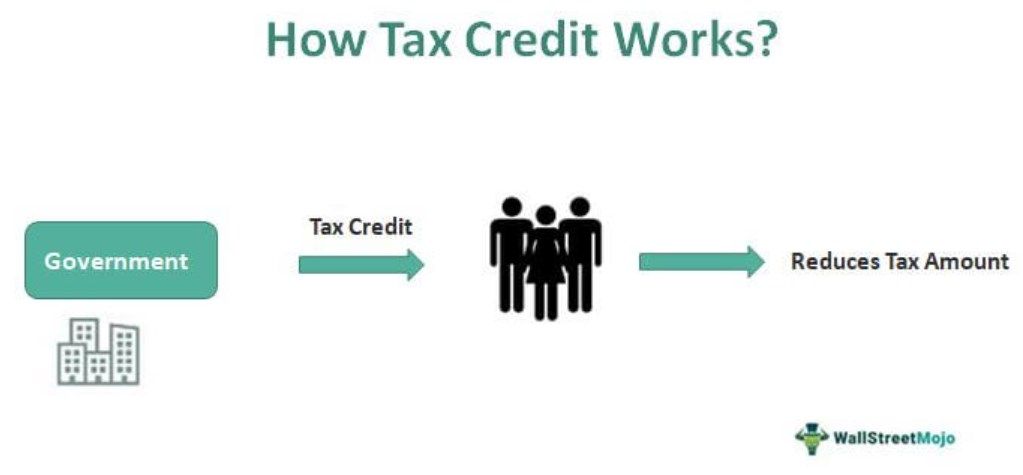Table Of Contents
What Is A Tax Credit?
Tax credit can be defined as a reduction in the total tax amount someone owes to the Internal Revenue Service (IRS). It can be considered a type of financial incentive provided to the citizens by the government to promote activities largely advantageous to society and the economy.

Tax credits help citizens reduce the tax they owe or get a refund on the amount they pay. The government gives credits only in specific and controlled circumstances as it provides greater benefits to the taxpayers and leads to exploitation. However, one must meet specific eligibility criteria to claim these credits.
Key Takeaways
- A tax credit is an incentive provided to the taxpayers by the government, effectively reducing the total tax paid.
- The credit can be in the form of a rebate or a direct reduction of the amount. There are three types of credits based on this – non-refundable, refundable, and partially refundable credits.
- Credits are not tax deductions. The former reduces the net tax amount paid, whereas the latter reduces the total taxable amount.
- Credits on taxes serve as a push to citizens and help them adopt activities recommended by the government.
Tax Credit Explained
The tax credit has two purposes – firstly, it acts as an impetus to motivate the citizens to take up measures of economic significance and contribute to society. Secondly, it provides support to the people in need. As citizens usually pay huge amounts of taxes, credits seem like an attractive option.
Credits offered for using solar power, electric vehicles, etc., act as a stimulus and encourage more people to adopt the system. In addition, other types like working or the disability tax credit acts as as financial support to deserving citizens.
The working or the earned income tax credit (EITC) reduces tax for people from the low-middle income range. The disability tax credit relieves persons with disabilities by decreasing their financial obligations.
Taxpayers can claim their credit while filing tax returns. Then, based on their eligibility and the total value of the credit, they can apply for the reduction, depending on the type of the credit. Also, they can use a tax credit calculator, available online, which uses information like adjusted gross income and credit value to calculate the tax amount owed, credits, etc. Alternatively, they can consult a tax professional for the same.
Here, it is important to note that credits are not the same as deductions. In the former, the credit amount is subtracted from the tax amount payable, whereas in the latter, the amount is deducted from the total taxable income. Hence, the benefits for taxpayers from credits will be more than from deductions.
For example, if a person’s taxable income is $50,000 and the tax rate is 22%, the total tax amount will equal $11,000. A tax deduction of $1000 will reduce the taxable income to $49,000. It will give a tax amount of $10,780. But the credit of $1000 will reduce the amount owed to $10,000. Thus, the credit provides more gains (here, $780).
One can claim tax deductions as either standardized or itemized. Some popular tax deductions are for the mortgage, charitable donations, medical expenses, etc.
Types of Tax Credit
There are three main types of credits – non-refundable, refundable, and partially refundable.
- Non-Refundable Credits: Such credits are usually given for mortgages, education, etc. The taxpayer can reduce the amount they owe using their credits. However, if the amount reaches $0 and their credit value exceeds the tax amount, they will not get a refund. Such credits are valid only for a year and are not carried over to the next years. For example, if the tax amount of a person equals $1000 and they have a credit of $1200, their amount will be bought to $0. Hence, they will not have to pay the amount, but the balance of $200 of the credit will go unutilized. This amount will not be transferred to the next year either.
- Refundable Credits: Eligible taxpayers entitled to tax refunds will get the balance credit amount if any. It benefits the taxpayers, as they can enjoy the full value of the credits. Working Tax Credit is a type of refundable credit. In the above example, the taxpayer gets a reduction of $1000 on the tax they owe and also receives a $200 refund.
- Partially Refundable Credits: The taxpayer receives a percentage of the balance credit amount. For example, if the excess credit amount is $200, a person receive a rebate of 40% or so, depending on the type of credit. The American opportunity tax credit is one such example.
Examples
Consider the following examples to get a better idea:
Example #1
Let’s look at the case of country X. The government decides to offer a 25% credit to individuals who have installed solar power systems in their homes. The decision was taken to promote the use of renewable sources of energy. As a result, many consumers adopted solar technology and they received credits for it.
Example #2
Here’s a real-life example of the United States automobile industry racing to beat China and Europe in the electric vehicles (EV) revolution. Automobile giants like General Motors, Ford, and Toyota are requesting the government for a $7500 purchase credit. The credits are important for the country’s goal to achieve 50% EV sales by 2030.
Without the credits, the companies would shift production to China or Europe. According to the Boston Consulting Group (BCG) estimates, the country will achieve 47% of the EV sales with the incentives. Conversely, if the government fails to incentivize, it will only be able to reach 35% of the sales.

